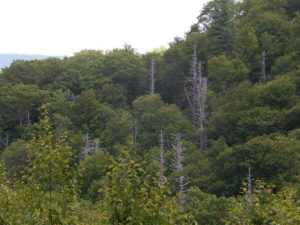Increasingly, the trend of globalization causes many species to be moved around the world and into areas in which they have never before existed.
Unfortunately, when organisms are moved out of the regions where they evolved and transported to new regions where there are few or no natural limiting factors – predators, as an example – populations can sometimes explode with profound impacts on the new and vulnerable territory.

Sign on a tree warning of emerald ash borer damage (SBSArtDept)
This is particularly true in forest ecosystems that generally receive little human intervention over long time periods.
As a consequence, forests around the world are increasingly being altered by invasions of alien plants, insects, tree pathogens (such as fungi) and other types of organisms.
The impacts on the ecological, economic and sociological aspects of affected ecosystems are often severe, widespread and long-term.
A IUFRO Task Force on Forests and Biological Invasions has been established to gain new insight into this issue by synthesizing information across a range of scientific disciplines.
“IUFRO is the premier international organization that facilitates networking and the exchange of information among scientists working on forests,” said Dr. Andrew Liebhold of the U.S. Forest Service and coordinator of the Task Force.
“As such, IUFRO offers a fantastic resource for reaching out to scientists worldwide. This Task Force will tap into that by both facilitating the synthesis of scientific information and by disseminating that scientific knowledge, ” he said.
Biological invasions are problems in forests of virtually all forested regions worldwide, regardless of whether these regions are economically developed. The IUFRO network provides an excellent infrastructure for sharing knowledge among regions and in particular in countries that lack access to much of the scientific literature, he said.
The Task Force is expected to provide opportunities to minimize the number of new invasions. In part, it is hoped this will be accomplished through information sharing. Dr. Liebhold feels this will allow countries around the world to reduce the chances of species inadvertently being transported through trade or human travel.
“It can also make it possible for forest managers to learn to manage or adjust to the presence of biological invasions and minimize negative outcomes,” he added.

Hemlock killed by hemlock woolly adelgid. Photo by Laura Blackburn/US Forest Service.
Since there is no expectation that globalization will stop and, in fact, it is expected to expand in future, the Task Force will contribute by gaining new insight into the issue and thus help institutions guide their research efforts internally and to coordinate among various countries.
The Forests and Biological Invasions Task Force is one of several established by IUFRO to advance knowledge under five research themes in accordance with the IUFRO 2015-19 Strategy.
The five themes are:
Forests, Soil and Water Interactions;
Forests for People;
Forests and Climate Change;
Forests and Forest-based Products for a Greener Future;
and Biodiversity, Ecosystem Services and Biological Invasions.
Find out more about the Task Force at: http://www.iufro.org/science/task-forces/biological-invasions/

Leave a Reply